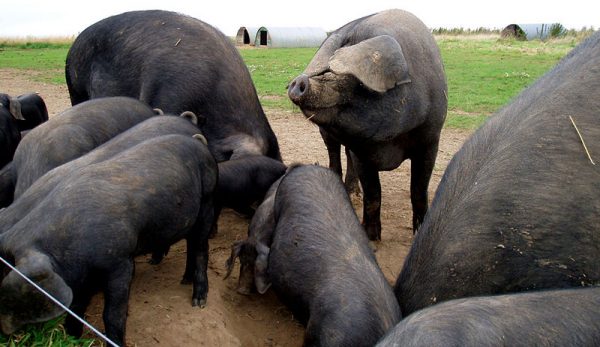
When you get down to it, simple economics should dictate there be only one pig breed on the planet—one with a high feed conversion rate (requires the least amount of rations to put on muscle, also known as “meat”), that reaches optimal weight in the shortest amount of time, and that doesn’t require much in the way of maintenance from the farmer.
A Practical Pig
This pig exists, of course, and it’s the backbone of the hog industry.
The most recorded pig in existence on American farms, the American Yorkshire, makes up the bulk of porcine animals in intensive farming operations. That’s primarily because these animals quickly put on weight with the smallest amount of feed. They’re also especially well adapted to factory farm conditions.
Many people aren’t fond of some things that happen on these farms, and the breed’s taste profile is largely considered inferior to other pigs. Yet the scale of our country’s demand for pork requires these particular animals to maintain profitable farming operations.
Bucking Trends
I’m among those who grumble about things such as concentrated animal feeding operations, commonly called CAFOs.
Raising pastured pigs on my farm was very much a reaction against industrial practices. But I’ll also eat a piece of bacon in a restaurant I know didn’t come from an animal that enjoyed the fresh air my pigs do. So I’m in no position to be sanctimonious.
Rather, I want to discuss why anyone would raise another breed of pig any other way—why I would and do, in fact.
While I know enough about raising pigs to get by (and I’m foolhardy enough to try to figure out the rest), I can’t claim to know much about economics. I do, however, understand that sometimes slight shifts in buying trends open up little pockets where alternative markets can thrive.
Slow It Down
The Slow Food movement created one of these pockets. Founded in 1986 by an Italian political activist (I know, but stick with me) to promote ideas about eating that run counter to a fast-food culture, the founders wrote the Slow Food Manifesto in 1989 to put forth some specific ideas.
While a manifesto drawn up around ideas of eating might seem a bit wacky, Slow Food’s ideas mirror some that are common to many hobby farmers. The manifesto simply says that things are, in general, moving too damn fast these days, and we really need to slow down.
It maintains that shifting away from an “eat to live to work” mentality is the best first step away from fast living. The piece further says that we should choose to savor regional meals made from local ingredients grown without pesticides or other industrial farming practices that require an unsavory compromise on the part of the eater.
If this doesn’t sound revolutionary, it’s because it isn’t—not today.
Today, folks such as you and I can live a bit farther out of the city center than makes pure, pragmatic sense. We can do this because we want fresh air and backyard eggs. But in the 1980s, they made goofball Chevy Chase comedies about people who did that.
Slow Food and other like-minded organizations advanced ideas about eating well and growing your own food when fast food restaurants and TV dinners were in full swing. And I believe it’s safe to say we’re partly where we are today because of these kinds of manifesto-drafting organizations.
Sub
I know this sounds like an ad for Slow Food, but I’m not a member or anything. (Maybe I should be, but, you know … that restaurant bacon).
That said, I like to reference this group when I tell people our farm raises what I like to call “slow pork.” Our pigs take longer to reach market weight and they eat more, so they cost more per head than industrial farmers pay.
But they taste better. And our market customers choose to pay a little extra for heritage breeds raised locally on a small, sustainable farm. We, in turn, get to experience a lifestyle that runs counter to the “fast life” culture.
Because we can farm this way, breeds such as Large Blacks (pictured above), Gloucestershire Old Spots and Berkshires can persist and enjoy lives outside. All this despite the fact that simple economics should have eliminated them and pasture pig farming by now. (In fact, many of these breeds did almost go extinct in the face of industrial farming.)
It’s not perfect, but there are some significant wins.
Slow and steady don’t have to win the race so long as it has a place in the game.




